By Jack Delaney
A visitor to the New York Tattoo Convention last Friday might have been caught off guard by the sudden blare of bagpipes, erupting from three kilted men as they strode down the aisles of artists’ stalls. But to Donal Cranny, one of the event’s three organizers, they were no sideshow. Instead, the marching musicians were emblematic of a broader approach: “We wanted a very global experience,” Cranny said.
To that end, the show assembled 340 artists from across North and South America, Europe, Asia, and Australia who converged on Duggal Greenhouse in the Brooklyn Navy Yard over the weekend, from October 18 to 20, for the annual convention’s third edition. Their art drew over 4,500 attendees, who clustered around food trucks, danced to live acts like the hard rock outfit Rebel Angels, and lay patiently on tables as steady hands added fresh designs to their collections.
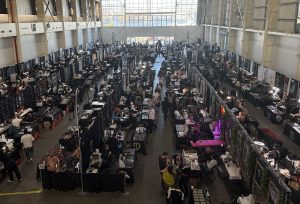
Tattooing has a long and checkered history in New York City. In 1870, Martin Hildebrandt founded one of the first tattoo parlors on Oak Street in Manhattan, catering to soldiers and sailors for whom a tattoo was partly style, and partly a means for their body to be identified if they were killed in battle. The city banned tattooing altogether in 1961, catalyzing a Prohibition-like underground scene and persisting for thirty six years, until 1997. Today, events like the New York Tattoo Convention are evidence that the practice’s old connotations may be slowly shifting.
Michaelle Fiore, who opened a studio in Gowanus this summer and had attended the previous year’s convention at South Street Seaport, said that the pandemic had changed the scene significantly. “A lot of people are either opening private studios,” she said, “or going in the direction of co-ops where multiple artists are pitching in for a space and then splitting rent down the middle, rather than working for a shop owner.” In her view, customers were gravitating more and more towards these new models — studios based out of artist’s homes, for example — and modern styles, too, such as neo-traditional, a digitally-inflected take on classic motifs. Her own preferences are surrealism, anime, and fine line work.
Fiore also noted that she was already seeing a post-pandemic bump in demand for cover-ups and laser removal, as the pent-up demand for tattoos gave way to second thoughts. Fiore’s mother, a painter herself, sat beside her on a swivel chair and chimed in with the refrain of parents everywhere: “Think about what you’re going to get first!”
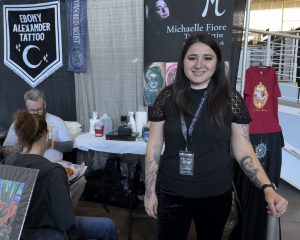
Nearby, as “Psycho Killer” by the Talking Heads played on the loudspeakers, and a shirtless man showed off two hyper-realistic babies’ faces, one on each of his pecs — plus a third on his shoulder blade, which he displayed with a smile to an admiring passerby — Coy Barrientos waited sagely in his sunny stall for customers. This was his first year participating, and he had only recently moved to Grand Junction, CO, from his home in Costa Rica, for a residency at Elysium Studios.
“I’m definitely surprised that I’m even able to make a living out of art,” he said, beaming. He had worked his way up from tattooing friends in his bedroom, to a three-month apprenticeship, before landing this position in the U.S. Like Fiore, he was influenced by Japanese iconography, and agreed that the industry seemed to be changing. One factor, with which artists will increasingly need to reckon, is artificial intelligence.
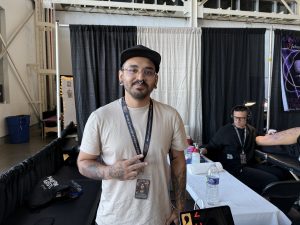
“You kind of notice the before and after of someone’s Instagram page,” Barrientos said, “when they start to use AI.” For some artists, he saw a marked improvement in their work, so he hesitated to condemn it wholesale. “I don’t really think it’s bad, but it’s a contradiction. If you’re making art, you’re supposed to be making it yourself — otherwise, you’re not really the artist. At the end of the day, AI art is not yours.”
Chumreon Sutcharitakul, owner of the Tattoo Stock shop in Astoria, said that he occasionally used AI-created designs for reference, but doubted that the artist’s role would ever be fully eclipsed. His own start had been decidedly low-tech: with “nothing much” on Youtube in the early aughts, he had resorted to buying instructional DVDs made by tattooer Jeff Gogue on Google. Then, in 2009, he found a spot at a studio on West 4th Street with a clientele of mostly tourists.
“I didn’t have the chance to pick something I wanted to do. It was good for me, and it’s good for beginners because they have to practice many styles,” said Sutcharitakul, who transitioned to his own studio in 2016 and moonlights as an amateur billiards player. “Me, I call my style money-listic. You pay me, I do whatever.”
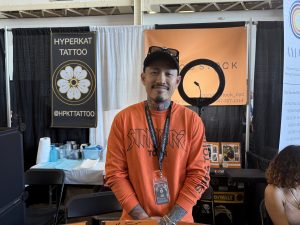
Though not every vendor was so explicitly mercantile, few contested that tattooing was just as much a matter of savvy business sense as it was artistic skill. “Nowadays, social media is big,” Sutcharitakul explained. “If you don’t learn that too, you’re dead.” Upstairs, as the sun began its descent over the East River, fellow industry veteran Ross Given seconded that sentiment. While he called himself a “dinosaur” when it came to social media, he had a secret weapon: his two kids, whom he relies upon when he needs to shoot a video for Instagram Reels or TikTok.
Given, owner of the Anubis Tattoo Studio in Greenock, Scotland, has been tattooing for 17 years, but he stumbled into it initially. “This wasn’t a career plan,” he said, “or a conscious decision.” After leaving the Royal Air Force, where he had served for 12 years, he had been gearing up to start a new job in private security. By that point, he had been tattooing part-time for two years, inspired by an artist in Norfolk, England, who had given him tattoos of his own while he was stationed there. While back home briefly after military service, he ultimately decided to take the plunge and stay to open his own shop.
“I was kind of lucky, I had some money put aside,” Given said. “And I just thought, ‘I’m going to give it a go.’ In my hometown, there were only two other artists. They were older guys, they weren’t very good.” He flashed a grin. “So I thought, I can’t be any worse.”
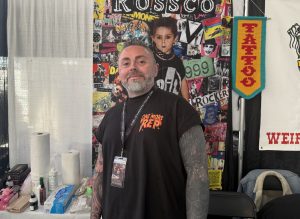
At the convention, Given’s winding path seemed the rule rather than the exception. Another artist, Alan Gray, had started tattooing at age 14 while part of a gang in Mexico City, and had dreamed of attending a prestigious program at the National Autonomous University of Mexico for plastic arts. At 20, he moved to New York and has been tattooing professionally ever since. “You’ve got to love this,” he said, “and you’ve got to keep working every day.”
Emanuele Baracchi, cleaning his equipment, explained that he hailed from a small town outside Bergamo, Italy. “[Before tattooing,] I was doing a bunch of jobs. My father had a big pub back in Italy, so I was taking care of the pub as a manager. I worked as a gardener, and as a croupier.” His last job was in a factory that made metal connectors for trains, before he promised himself he would follow his passion for tattoo collecting and become an artist himself.
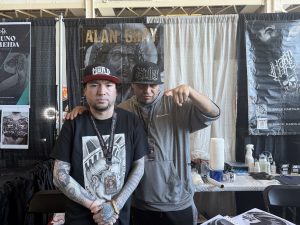
No matter their background — a past life in the Air Force, a gang, or the foothills of the Alps — that devotion to their work, and desire to keep making, were common denominators. Now at The Grand Reaper, a shop in San Diego, Baracchi summed up the profession’s goals thus: “You try to make a living, but by expressing art through people. And you try to make people confident in their lives. It’s like armor. Every tattoo should have a meaning, a reason.”
The convention concluded with a ceremony for the Best of Show, which went to Hugo Feist and Anton Mariushev for a collaborative piece.
Cranny and business partner Roy Keane conceived of the concept in 2020, as the pandemic was raging. It took two years to actualize that vision, but they are now planning a fourth installment, set to be in Brooklyn again, and this summer they launched a sister convention back in Belfast, Ireland.
“We’re three years in — it’s become like riding a bike,” Cranny joked. “And I like to think that we’re creating a community for people who want to come back.”
Until then, the artists will be scattered across the globe, honing their crafts for next year.


